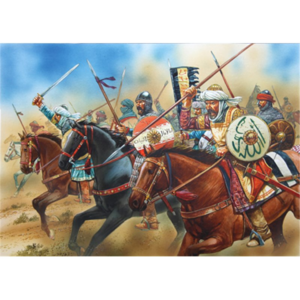Battle of Tell Saqara
| Battle of Tell Saqara | |||||||
|---|---|---|---|---|---|---|---|
| Part of Rawwadid conquest of Northwestern Mansuriyyah | |||||||
 Rawwadid cavalry charging | |||||||
| |||||||
| Belligerents | |||||||
| Rawwadid Sultanate |
| ||||||
| Commanders and leaders | |||||||
|
Sultan Sayfuddin Ghazi Adnan Kanligöz Abdul Karim al-Hawasi Faraj al-Karwalabi |
| ||||||
| Strength | |||||||
| 40.000-50.000 troops |
26,000 levy infantry 12,000 Makedonian infantry 14,000 non-noble horsemen 6,000 archers | ||||||
| Casualties and losses | |||||||
| Most captured or killed | |||||||
The Battle of Tell Saqara was fought between the Makedonian Empire and the Rawwadid Sultanate in 4 April 1206 near Tell Saqara (modern province of Adnaniyah, Mansuriyyah). The decisive defeat of the Makedonian army and the capture of viceroy Zetes the Younger played an important role in undermine Makedonian authority in northwestern Mansuriyyah and opened the way for the conquest and subsequent Islamization of the region.
Sayfuddin’s scouts had located Makedonian forces one day ahead. Some of his generals suggested moving ahead and catching Zetes before he was ready, but considering his numerically inferior forces, Sayfuddin decided to fortify his position. Rawwadid forces set up camp at Tell Saqara hill, using the village of same name atop the hill to dominate the terrain. He sent ahead a small party to lure the Makedonian army into his position, where the first round of battle took place in the plains north of the hill. Feigning defeat, Adnan Kanligöz mercenary Turanian troops apparently retreated, depriving Sultan Sayfuddin of a major component of his army, which fell back to fortified positions on the hill, where they held up against Zetes’ advances, which were halted by the afternoon. In the following day, the Makedonians continued pressing on, until Adnan reappeared behind Makedonian lines, flanking them. As Zete’s confused troops tried to rearrange its formations, Sayfuddin ordered Emir Faraj al-Karwalabi’s Ghulam cavalry to charge against the weakened enemy lines, breaking them. The bulk of the troops, composed of locally recruited levies, broke down on a rout, with many preferring surrender. Zetes, separated from most of his troops during the confusion, surrendered, while the remaining Makedonian professional soldiers managed to regroup and form a shield wall from which they resisted the Rawwadid attack, but were eventually overwhelmed by the larger enemy force.
The battle resulted in a great victory for the Rawwadids and opened the way for their conquest of northwestern Mansuriyyah. With the bulk of its forces wiped out and deprived of its senior leadership, Makedonian resistance was mostly weak and ineffective, centered on major cities while waiting reinforcements from across the Matra Mountains. Zetes was taken captive to Adra, where he was well-treated, being eventually reunited with his family a few years later and given safe passage to return to Makedonian lands beyond the mountains after swearing not to take up arms against the Rawwadids again. Chroniclers of the time relate that Sultan Sayfuddin had the following conversation with the Viceroy:
Sayfuddin: “What would you do if I where brough before you as a prisoner?”
Zetes: “Perhaps I’d kill you, or exhibit you in the streets of Parilla."
Sayfuddin: “My punishment is far heavier. I forgive you, invite you to be a guest at my house, and will set you free when the time comes”
Sayfuddin imposed a modest ransom on the captured levy soldiers, personally relinquishing payment and freeing his share of prisoners, offering them to enter his service instead. This decision proved to be strategically sound, as most of the local populace resented Makedonian rule and started to see the conquering Rawwadids as liberators. The few captured Makedonian professional soldiers were imposed higher ransoms, with those unable to pay or unwilling to change allegiances sold into slavery.}}